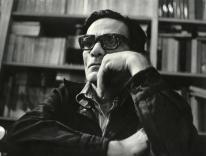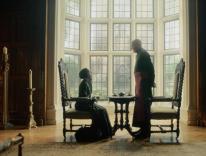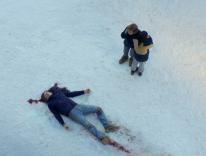Something odd happened in film theaters this summer: National Public Radio went to the movies. Or, at any rate, some of its stars did.
Will Shortz, the crossword-puzzle editor of the New York Times and weekly Puzzlemaster on NPR’s Sunday Weekend Edition, is featured in the documentary Wordplay, though Shortz is less the star of the film than its conduit. Through him we enter the world of those bright and amiable nerds (they embrace the epithet) who not only do crossword puzzles but obsess over them and enter national competitions, one of which provides this movie’s climax.
Wordplay itself is bright and amiable, but I believe that only a puzzle addict could find it compelling. Part of the problem is the relationship between the camera and the solving of crosswords. There isn’t any. There is virtually nothing for the camera to watch in the activity itself. As one of the tournament players puts it, when you compete you’re struggling with something in your mind with no one looking over your shoulder. Occasionally the camera does look over a shoulder, but to no avail; all we see is a pencil poised over paper. The filmmakers sometimes enlarge the puzzle so that it fills the screen. This makes for a pretty graphic but doesn’t increase the suspense or the human interest. By contrast, think of the spelling-bee kids in Spellbound. The emotions flitting across their faces as they struggle with esoteric words made that documentary unforgettable. How can you photograph a tournament where the emotions of the participants are hidden by hunched shoulders?
Yet you may be charmed by the competitors themselves, especially homely-beautiful Ellen Ripstein, who doesn’t want to confess her hunger for adulation even as it spills out of her every pore. Nobody onscreen is as compelling as she because everyone else is so kind, unpretentious, and fair-minded that you truly believe the entrant who says that winning doesn’t count, only the process does. This attitude makes for sterling character but little excitement. Wordplay is a gracious documentary that never quite succeeds in making the invisible visible.
And how do you make a radio show that is a triumph of invisibility into cinematic entertainment? The poignantly lonely Minnesota landscape that fills the first shot of A Prairie Home Companion suggests that anybody living there might well need a friendly visitor every Saturday night, even if it’s just a voice over the airways. On the soundtrack we hear, as some unseen listener twirls a dial, various kinds of pop music and religious exhortation until the dial comes to rest on Garrison Keillor’s famous program.
But wait a minute! Before Robert Altman’s film is five minutes underway, we learn that this celluloid version of the host isn’t the most popular entertainer in the history of noncommercial broadcasting but rather a local talent hosting a strictly local program on a commercial, mom-and-pop station, WLT, recently sold to a Texas corporation that has dispatched an axman (named, in a burst of denominating inspiration, “Axman”) to terminate the show. In this movie’s alternate universe, in this masochistic comic nightmare of Garrison Keillor’s, we are attending the death of something small, quaint, idiosyncratic, and Midwestern, murdered by something big, cold, corporate, and Texan. (Oh, did I mention that Garrison Keillor doesn’t much like George W. Bush?)
Of course, it has always been Companion’s central conceit that the show is indeed an old-time comedy-variety show-complete with ads for local businesses-in the tradition of 1930s hits like the Fred Allen and Jack Benny programs. And the very fact that Companion can now exist only on public broadcasting is a sign of the times. With the real commercial stations now specializing in one type of music or political commentary, Keillor’s show comes across as an oasis of multifariousness. Where else are you going to hear gospel music and Broadway tunes and jazz (a mild version of it, to be sure) and Marilyn Horn singing opera and Billy Collins and Donald Hall reciting their poems, plus Keillor himself telling us mostly comic but sometimes surprisingly bitter stories about Midwestern, middle-class people? Companion can be dismissed as middlebrow but now that popular culture has become so fragmented and specialized and often exudes such hostile vibes, Keillor’s show harks back to an era when commercial radio included Jack Benny, Texico’s broadcasts of the Metropolitan Opera, the Lone Ranger, Bergen Evans with his academic quizzes, Orson Welles doing Shakespeare and Martian invasions and Dracula and the Shadow, Dorothy Thompson analyzing European fascism, and Edward R. Murrow reporting the London Blitz. When this movie pretends that Companion is on a commercial station, the inherent suggestion seems to be that true populism has become, paradoxically, a minority taste.
Except for a brief epilogue, the movie plays out in “real time”-a two-hour show as a two-hour movie with the camera (superbly fluid cinematography by Ed Lachmann) roaming over both the stage and the backstage areas. Altman and Keillor must have rightly sensed that the music acts would work on film but that the comedy skits, so dependent on voices and sound effects to create a world strictly for the mind’s eye, would not. So, to fill in for what we don’t see of the onstage comedy, we are privy to the performers’ offstage joshing and hassling one another, with the radio show’s recurring comic characters passing as “real” employees of the show. And Keillor’s penchant for melancholy and the supernatural is also on hand with a lovely Angel of Death (a woman killed in a car crash when she got distracted by a Keillor joke) wafting through the Fitzgerald Auditorium. Keillor’s monologues, the center pieces of every show and as close to pure radio as you can get, are transposed (and, alas, diminished) into backstage blather.
A good plan, but unevenly carried out. All the onstage stuff works. As singers Yolanda and Rhonda Johnson, Meryl Streep and Lilly Tomlin have learned the idiom of country singing and use the music to extend and even exalt their characterizations: Streep demonstrates that a woozy airhead like Yolanda can attain ecstasy in her art, while Tomlin’s Rhonda is a depressive whose irritating kvetching gets distilled into a kind of noble melancholy. Woody Harrelson and John C. Reilly delight with a dirty-riddle routine; L. Q. Jones as a singing cowboy nearing his death is craggily sweet; Jearlyn Steel, with her ground-shaking voice and Junoesque presence, radiates the power of gospel; and even Lindsay Lohan scores with a supposedly improvised song that wraps up the show.
But time and again the backstage hijinks pull the movie down. This may be because both Altman and Keillor share a penchant for humor that is backyard bawdy, yet lame. Guy Noir, presented to my inner eye by Keillor on radio as rumpled but game, is here nattily incarnated by Kevin Kline who soon becomes an unfunny Inspector Clouseau doing schtick (phoning somebody standing right behind him) that was unfunny forty years ago. The moldiness of the gags douses Kline’s very real flair for physical comedy. Likewise, Harrelson and Reilly, so good as an onstage duet, are undone offstage by dumb dialogue and fart jokes. The smoothness of Altman’s staging and the gorgeous melancholy of the cinematography underline rather than mitigate the crudeness of the comedy.
But I must also admit that Companion’s weaknesses recede in the memory while the fetching images and vibrant performances linger. What a charmingly odd project: a cinematic requiem for a radio show still going strong; a tribute to the expansiveness of popular entertainment in an era in which fragmentation and monomania thrive.
Please email comments to [email protected] and join the conversation on our Facebook page.
Share
Previous Story
The Fantasy Man
Next Story
Can We Say No to a Friend?


